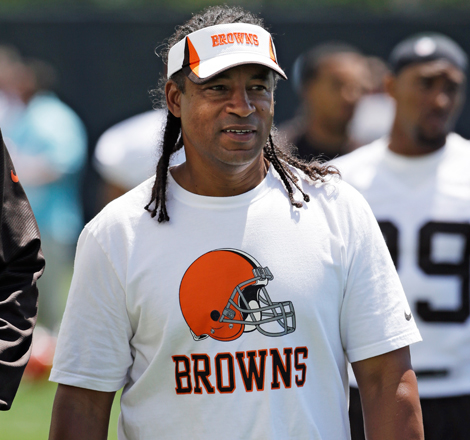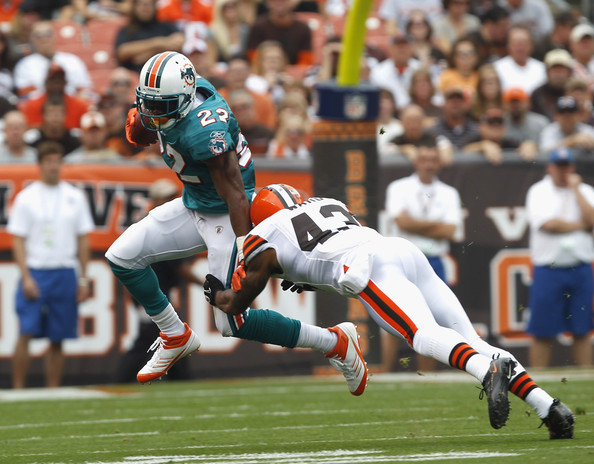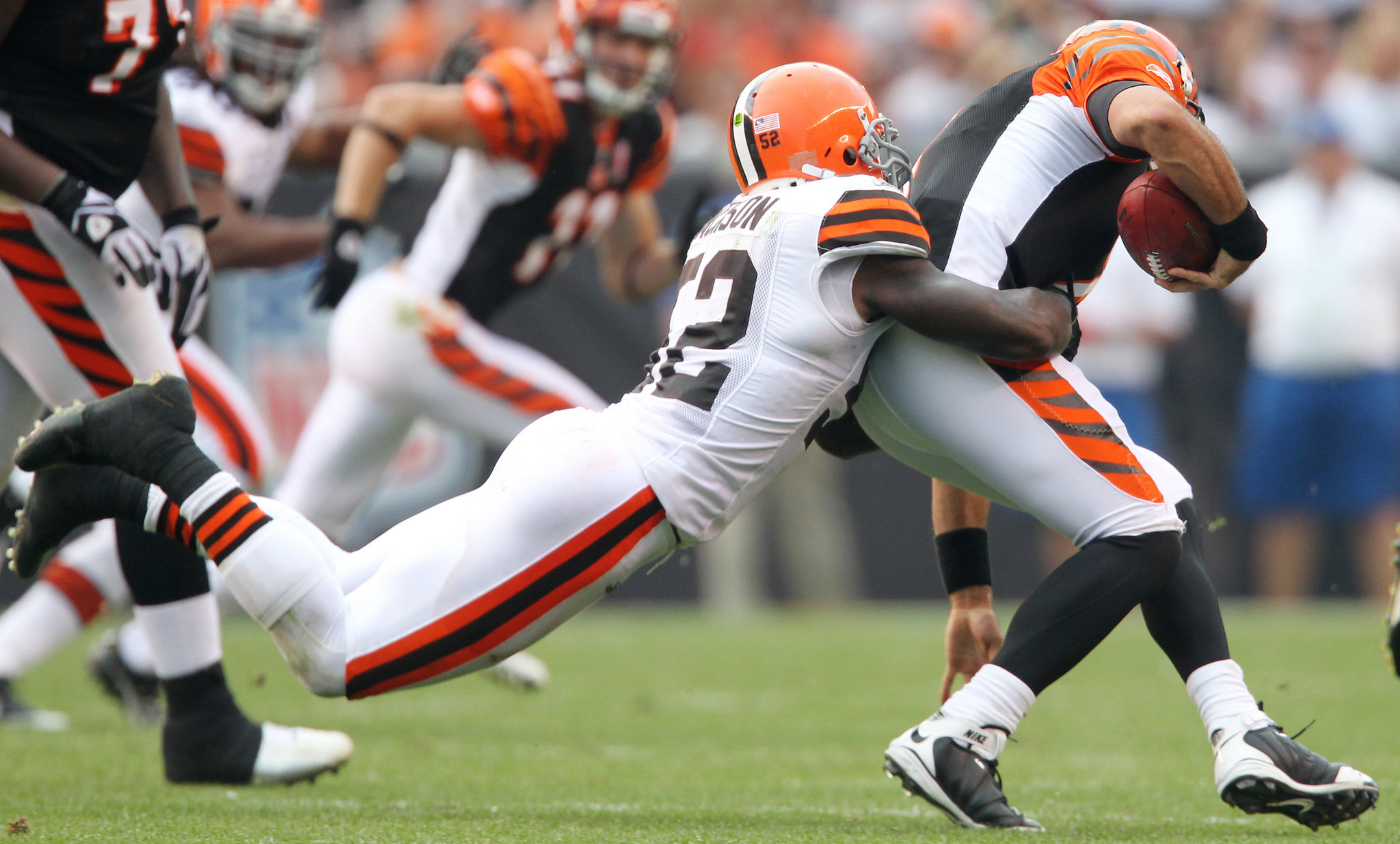 Browns Archive
Browns Archive  Browns Training Camp Preview Part 2: Ray Horton Wants Your QB
Browns Training Camp Preview Part 2: Ray Horton Wants Your QB
 The Cleveland Browns opened training camp on Thursday with new personnel and a new outlook on the defensive side of the ball.
The Cleveland Browns opened training camp on Thursday with new personnel and a new outlook on the defensive side of the ball.
While there will be plenty of new faces on defense this year, the most important addition may be defensive coordinator Ray Horton.
The Browns decided to make the switch to the 3-4 defense because, according to CEO Joe Banner, “most good teams play an attacking 3-4 defense,” citing Green Bay, San Francisco, Baltimore and Pittsburgh as examples. (Banner must have been otherwise occupied when the Giants won two Super Bowls playing a traditional 4-3. But that is a discussion for another day.)
Enter Horton, who comes to the Browns from Arizona and brings with him a 3-4 defense that is modeled after the one he learned from Dick LeBeau in Pittsburgh. Make no mistake; this isn’t going to be your father’s 3-4 defense, but rather one that is based on a key principle in today’s NFL – making the opposing quarterback pay in the passing game.
“We teach legal punishment of the quarterback,” Horton told The Plain Dealer. “You have to get after him.”
We could probably stop this preview right now as those words are enough to warm any Browns fans on a cold Northeast Ohio winter night.
While Horton’s defense is labeled as a 3-4, it’s really a defense based on matching-up to what the offense is showing.
As Brendan Leister points out at DraftBrowns.com:
In 2012, Horton used 3-4 fronts most when matching up with offenses that relied heavily on running the football and 21, 12, and 22 personnel. In two games against the San Francisco 49ers, Horton’s defense lined up in a 3-4 front on 36 out of 57 snaps (63.2%) and 55 out of 69 snaps (79.7%) respectively. Against the Chicago Bears in week 16, Horton matched up by using a 3-4 front on 45 out of 61 snaps (73.8%). The game that Horton relied most on the 3-4 was when he faced the New York Jets in week 13. Horton matched up with the Jets by using a 3-4 front on 67 out of 78 snaps (85.9%).
Throughout the entire 2012 season, Ray Horton relied on a variation of his 3-4 defense on 563 out of 1,110 snaps (50.7%). On first and second downs, Horton relied on a variation of his 3-4 defense on 520 out of 849 snaps (61.2%). On third downs, Horton only relied on a variation of his 3-4 defense on 40 out of 249 snaps (16.1%).
Horton likes to move his defensive pieces around and then bring pressure from a variety of spots with the goal of keeping the offense guessing.
“The players like it; I like it,” Horton said on the team’s website. “What I’m hoping is the opponents don’t like it. And it’s a great time for us in training camp to experiment with a couple different things, moving guys, position flexibility, scheme flexibility. It’s a learning process for me as well as them.
“Statistically, if you go back and look at this style of defense we are employing here, we don’t want big plays. We don’t want scoring plays. We stress deep-to-shallow, technique, understanding what the opponent’s doing. That’s the No. 1 goal, to stop them from scoring. We’ve got to practice it. We’ve got to develop a mindset, and an understanding of what we’re trying to accomplish here. The No. 1 thing is get the ball back for our offense.”
 The front office did its part to help Horton, adding new pieces to the existing players to give Horton plenty to work with, starting up front where free-agent signing Desmond Bryant joins Phil Taylor and Ahtyba Rubin in a defensive line rotation that also includes Billy Wynn and Phil Hughes.
The front office did its part to help Horton, adding new pieces to the existing players to give Horton plenty to work with, starting up front where free-agent signing Desmond Bryant joins Phil Taylor and Ahtyba Rubin in a defensive line rotation that also includes Billy Wynn and Phil Hughes.
“I’ve really been pleased with what (Taylor) has done, both from just understanding what he is doing to a technique standpoint to setting a tempo and the pace,” coach Rob Chudzinski said on the team’s website. “You will see him as the first guy in line down there in the drill work, all of the things you would ask him to do.”
Backing up the defensive line is a linebacker group that – if everything goes right – could be really fun to watch this year.
That could be a big if, though, as the Browns are counting on:
- Free-agent linebacker Paul Kruger being the player that had nine sacks during the season last year and an additional four-and-a-half during the playoffs, rather than the one who was only on the field for 22 playing in the Super Bowl because he was ineffective in the run game.
- Third-year defensive end Jabaal Sheard making the transition to outside rush linebacker.
- First-round draft pick Barkevious Mingo being able to hold up against NFL-size offensive lineman while weighing under 240 pounds and making the switch from defensive end at LSU to outside linebacker with the Browns.
There is also the question of who will start alongside D’Qwell Jackson on the inside and just what Horton can do to keep Jackson from getting destroyed by opposing guards like he did the last time the Browns played a 3-4 base defense.
“(Jabaal) was one of the surprises of OTAs and minicamp for me,” Horton told The Beacon Journal. “I think when you have good athletes they can do a lot. He’s really done a good job of absorbing the defense and playing both sides. He is really going to be a versatile player where I can use him to move him around and use his skill to the best of his ability.”
 Possibly the biggest question about the front end of the defense is how will Horton get all his interchangeable parts on the field if the other team is running a fast-paced offense? We won’t know until we see it in action, but these things always seem to work out in Cleveland, don’t they? (No need to answer that.)
Possibly the biggest question about the front end of the defense is how will Horton get all his interchangeable parts on the field if the other team is running a fast-paced offense? We won’t know until we see it in action, but these things always seem to work out in Cleveland, don’t they? (No need to answer that.)
The Browns may need to pressure the quarterback, at least early on in the season, because the defensive secondary remains, to put it mildly, a work in progress.
Returning starters Joe Haden and T.J. Ward are solid, but who will be lining up next to Ward and opposite Haden remains a mystery.
The Browns selected corner back Leon McFadden in the third round of the draft and signed corner back Chris Owens to compete with Buster Skrine.
McFadden was compared to Atlanta corner back Brent Grimes by NFL.com in its draft preview (good), but at 5-foot-9 and 163 pounds (two inches shorter and 27 pounds lighter than the less-than-large Haden) is a pick that goes against the current NFL trend of larger corner backs (possibly bad).
Owens played 176 snaps for the Falcons last year, starting out as the team’s nickel back before being moved to the dime back role. Pro Football Focus gave him a rating of +4.9 for his play. By comparison, Sheldon Brown, last year’s starting corner back, graded out at +7.5 but was not asked back by the team. Make of that what you will.
As for Skrine, well he’s still Buster Skrine.
With the emphasis placed on passing in today’s NFL, all three should see time on the field during the season in some form or another.
At safety, sixth-round draft pick Jamoris Slaughter, who is in camp practicing after playing just three games last year after suffering a torn Achille’s tendon, will battle Tashaun Gibson and Johnson Bademosi (who has never played safety) for the starting spot next to Ward.
Even as an optimist, Horton knows it may take time for the secondary to get its act together.
“We will find somewhere in our mix of young DBs some good young starters that they’re going to have to step up and prove that they can play very good winning NFL football,” Horton said. “That’s going to be a position of need, of expectation, of careful scrutiny of can we do it? Can the young guys handle it? That we’ll find out. I don’t have that answer yet. It’s a concern of ours that we have to find quality starters and depth there.”
It’s understandable that fans are getting excited about the potential of a Horton-coached defense. After all, the bar is set pretty low when it comes to the Browns on defense, as they have only ranked higher than 15 once since 1999 and were 23rd last season.
 “As a defensive player, you have a mindset of wanting to be aggressive, and (Horton) utilizes that,” Jackson said on the team’s website. “He’s a smart guy, and we have smart players that can get it done. You can’t be able to run different sets or multiple looks and pressures if you don’t have the guys capable of doing it. I think we have smart guys and guys that play tough. It’s going to come down to everyone grinding throughout the season, doing what they’re supposed to do and be consistent about doing it.”
“As a defensive player, you have a mindset of wanting to be aggressive, and (Horton) utilizes that,” Jackson said on the team’s website. “He’s a smart guy, and we have smart players that can get it done. You can’t be able to run different sets or multiple looks and pressures if you don’t have the guys capable of doing it. I think we have smart guys and guys that play tough. It’s going to come down to everyone grinding throughout the season, doing what they’re supposed to do and be consistent about doing it.”
But there are still a lot of questions about the defense and a lot of things have to go right for everything to work. The defense may look ugly at times – especially early in the season – but it should also be a fun unit to watch.
We like the fact that Horton comes to the team with a bit of a chip on his shoulder after being passed over for coaching jobs – primarily in Arizona. That should help fuel what appears to already be a pretty hot fire in him.
“Are there expectations there for us to be good ... yes,” Horton told The PD. “To be great immediately ... probably not. But do I expect us to be better than last year, better than what most people expect? Yep, I do.”
Get ready Ben Roethlisberger, Joe Flacco and Andy Dalton. Ray Horton is ready to release the poison.
In case you missed it, here is our preview of the offensive side of the ball.
(Ray Horton photo by ClevelandBrowns.com)
(Remaining photos by Getty Images)
- NBA Announces 2013-2014 Schedule
- Browns Ink Sharknado
- Sharknado A No-Show For Rookie Camp
- Trent Richardson Out Until Training Camp
- Browns Sign Brandon Jackson
- Carrasco Suspended Eight Games
- Browns Add to Wide Receiver Depth with David Nelson
- Browns Need to Learn from Past Draft Mistakes
- Browns Release Chris Gocong and Usama Young
- Browns Missing on Grimes Disappointing, But Not The End
The TCF Forums
- Official- Browns Coach Search/Rumors
HoodooMan (Tuesday, January 21 2014 1:36 PM) - Movies coming out
rebelwithoutaclue (Tuesday, January 21 2014 12:56 PM) - 2015 Recruiting
jclvd_23 (Tuesday, January 21 2014 12:38 PM) - The 2014 Offseason Thread
Larvell Blanks (Tuesday, January 21 2014 12:25 PM) - Chris Grant's first 3 drafts
Kingpin74 (Tuesday, January 21 2014 10:13 AM) - Mike Brown
YahooFanChicago (Monday, January 20 2014 11:15 PM) - 2014 Hoops Hockey Hijinx
jpd1224 (Monday, January 20 2014 4:44 PM) - 2014 Recruiting
jclvd_23 (Monday, January 20 2014 2:26 PM) - Wish List - #4 Pick
Hikohadon (Monday, January 20 2014 1:26 PM) - #1 overall pick Anthony Bennett
TouchEmAllTime (Sunday, January 19 2014 1:28 PM)



